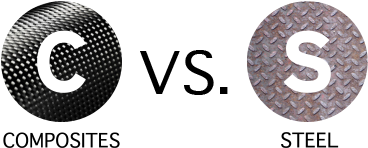Composites vs. Other Materials in Sports and Recreation
Composites have made a huge impact on sports and recreation. Design flexibility and high strength to weight properties in particular, have helped athletes reach their highest performance potential in virtually every sport: from football helmets, tennis rackets and golf clubs, to bicycles and bobsleds.

- Excellent strength to weight ratio: Composites offer the advantages of a significantly higher strength-to-weight ratio than steel.
- Corrosion resistance: In outdoor applications, composites stand up to severe weather and wide temperature changes, whereas steel rusts easily.
- Design flexibility and ease: Structures with a wide range of complex shapes and geometry can be made relatively easily compared to traditional steel methods.
- Lightweight: Composites are lighter than most wood and therefore easier to work with and install, require less labor and lowered equipment costs.
- Dimensional Stability: Composites retain their shape and size when they are hot or cool, wet or dry. Wood, on the other hand, swells and shrinks as the humidity changes.
- Lower maintenance costs: While composites may cost more upfront, their longer lifecycles reduce long-term maintenance costs.
- Design flexibility and ease: Structures with a wide range of complex shapes and geometry can be made relatively easily compared to aluminum.
- Corrosion resistance: Composites hold up to the elements better than aluminum.
- Fewer Parts: A single composite piece can replace multiple aluminum parts that must be fastened together. As a result, composites reduce weight, cost and future maintenance.
